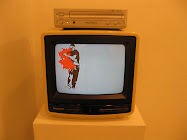This is a rare opportunity, the mounting of an exhibit involving the MoMA, MFAH, Centre Pompidou, and other institutions. The oddity here is that a vast debt is owed to the relatively demure Menil Collection; treasures donated by the deMenil family to leading museums were pulled for the exhibit from vast collections in vaults, in some cases ignored or forgotten by their owners. A Modern Patronage mobilizes the particular intricacies of the deMenil’s collecting practices and doubly serves as a measure of the type of works deemed proper to be donated to some of the world’s greatest art institutions. In situ, the show exists in support of a few works that stand head and shoulders above the rest. An innovative mix of tribal artifacts from around the world and mid-century Modernism, the exhibit contrasts the forms of a wide range of artworks, finding similarities in disparate sources.

Oil on canvas
The Museum of Modern Art, New York; Gift of D. and J. de Menil
(c) The Museum of Modern Art/Licensed by SCALA /
Art Resource, NY. (c) ARS, NY
This

Oil and enamel on canvas
Musee National d'Art Moderne, Centre Georges Pompidou, Paris
CNAC/MNAM/Dist. Réunion des Musées Nationaux /
Art Resource, NY (c) ARS, NY. Photo: Jacques Faujour
The lynchpin of A Modern Patronage is a late Pollock, The Deep, on loan from the Pompidou Centre in

Andy Warhol, Big Electric Chair (1967)
(not included in the exhibition)
137,2 x 185,2 cm, Collection Froehlich, Stuttgart
The fourth and largest room holds a blush of bright electric chairs, four paintings by Andy Warhol from different periods in his career including Lavender Disaster. The space is balanced by three large sculptures; two oversized Oldenburg sculptures in white, one an electric fan that dangles from the ceiling, the other a sunken drum kit, and a Larry Rivers sculpture with two pairs of female figures perpetually reversing the roles of dominance, satirizing Manet’s Olympia. Two models for Christo’s early works and their mock-up collage photographs are playful sculptures. As miniatures their absurdity is blunted by the reality that; yes, the artist did go around wrapping buildings in massive swathes of cloth. Coyly curated, the Menil Collection’s laissez faire attitude sells less books and tee shirts than the rest of the uber-branded museum world, but their prudishness can buy clout in short supply with those willing to look hard enough.
in the new issue- Artshouston























0 comments:
Post a Comment